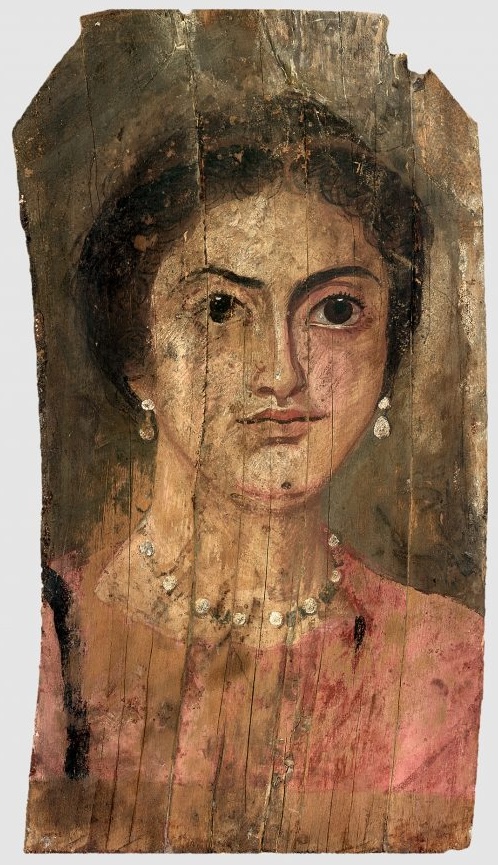
AMSTERDAM – Face to Face: The People Behind Mummy Portraits, an exhibition at the University of Amsterdam’s Allard Pierson Museum, brings together more than three dozen examples of Egyptian mummy portraits. The portraits, created in the first centuries of the Common Era in Egypt after it came under Ptolemaic and subsequently Roman rule, are among the most striking and often most realistic examples of Classical portraiture. The portraits were painted to represent how the dead had appeared in life and were originally attached to the mummified remains of their subjects.
The exhibition includes examples of mummy portraits from the Allard Pierson collection, but also from many other museums, including the Louvre and the J. Paul Getty Museums.

Portrait of a woman, Second half of the 2nd century CE, perhaps from Thebes, Louvre Museum [Wikimedia Commons]
As Artnet News notes, the portraits are one of the few large groups of paintings that have survived from the ancient world due to the ephemeral nature of the materials. We tend to think of the ancient Mediterranean in terms of monuments and statues made of pale stone, but in fact, there were plenty of painting traditions in many mediums – it’s just that most of them did not survive to the present. But as with many other artifacts, Egypt’s desert climate helped to preserve these mummy portraits when other climates would likely have destroyed them.
The mummy portraits owe more to Greek and Roman traditions than to pre-Ptolemaic Egypt, eschewing the famous stylization of dynastic Egypt for a realism that may strike modern viewers as more in line with modern ideals of portraiture.
The subjects of the portraits seem to largely have been wealthy Egyptians, whose fashions seemed to blend the cosmopolitan Roman and the distinctively Egyptian. “They are living in a multicultural context just like many of us do,” said Egyptologist Jen Thum to The Harvard Gazette, who curated another exhibit on mummy portraits in 2022. “They might identify one way in one context in their social life, and one way in another.”
While the portraits certainly appear realistic, experts do recommend caution before assuming these were exact facsimiles of their subjects’ daily appearance. “It’s difficult to judge the extent to which the paintings reflect what these people actually looked like,” Ben van den Bercken, curator of the exhibit, told Artnet News. “If, for instance, they really owned the jewelry we see in the images. It’s possible people were presented a bit wealthier than they actually were.”
But while the style of art and the fashions on display may be keyed into the greater Roman world, the context of these paintings is as much a part of Egyptian religion as anything in the Valley of the Kings. “They were made to be placed on top of mummified bodies,” van den Bercken said. “That’s the Egyptian component: a means of keeping the deceased recognizable for the gods as well as their loved ones.” Indeed, one reason why the practice fell out of style in the late 4th century may be because of the spread of Christianity into Egypt, which replaced mummification with new forms of funerary practice.

Mummy portrait of a woman [courtesy University of Amsterdam]
The mummy portraits are sometimes called the “Fayum” portraits because they were most commonly found in the Faiyum Basin surrounding Hawara and Antinoopolos, the latter named after Antinous, the deified lover of the emperor Hadrian. Examples of the portraits have been found throughout Egypt, however; so “Fayum mummy portraits” often refers to the style broadly, rather than to portraits from that specific area.
The exhibition follows a study of 12 of the portraits by Allard Pierson Museum announced last April, in which researchers used modern scientific techniques to learn more about the materials and processes that went into creating the portraits. Popular Archeology notes that this study was aimed at learning where the pigments and wood came from, how the portraits were changed over time, and especially about the lives of the deceased subjects.
Face to Face is on display at the Allard Pierson Museum until May 30th.
The Wild Hunt is not responsible for links to external content.
To join a conversation on this post:
Visit our The Wild Hunt subreddit! Point your favorite browser to https://www.reddit.com/r/The_Wild_Hunt_News/, then click “JOIN”. Make sure to click the bell, too, to be notified of new articles posted to our subreddit.